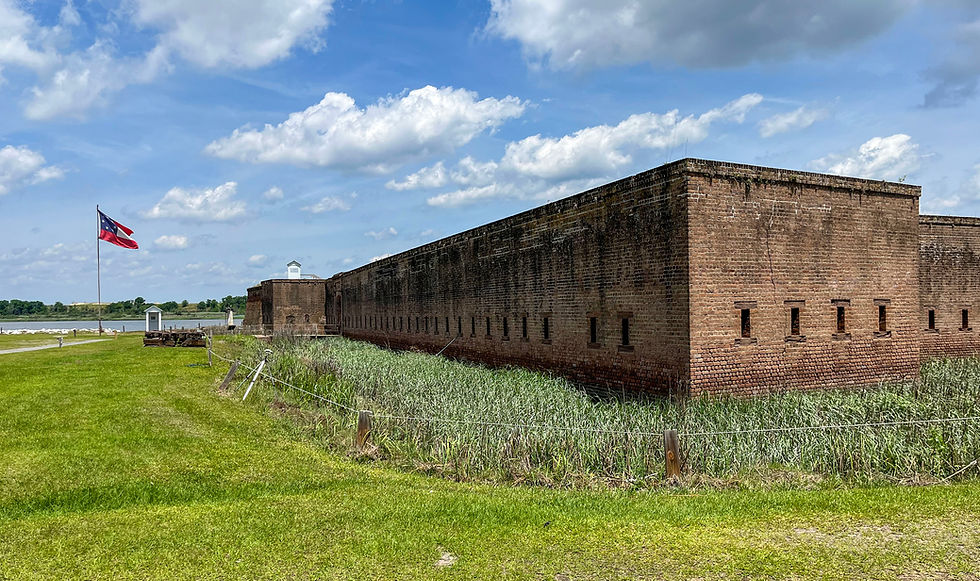Great Falls
- Tim Murphy

- May 25, 2018
- 6 min read
Updated: Apr 24, 2021
Two states. One incredible destination. The rapids at Great Falls are some of the most majestic on the East Coast and draw millions of tourists each year. The Potomac River plummets nearly 80 feet at this location, creating a series of beautiful whitewater cascades and jagged rock formations. The uniqueness of this landmark also creates one of the most ecologically-diverse ecosystem in America, with over thirty distinct plant communities and hundreds of animal species. Great Falls' roaring torrents have been sustaining this environment for hundreds of thousands of years, but it's only recently that the water's resources have helped aid human activity.

Members of the Algonquin and Piscataway tribes established thriving communities along the Potomac River during the Archaic Period (8000 BCE - 1000 BCE). Archaeologists have recently discovered that these people had extensive trading and social networks outside the local region. Moose antlers and copper items have been uncovered at Great Falls, indicating that tribes on the Potomac had contact with tribes from the Great Lakes region and New England. In the early 1600s, Native Americans encountered a new people--English colonists. The English established settlements and plantations east of the falls due to its fertile land and easy access to the Atlantic Ocean. In doing so, they took away valuable natural resources from the indigenous tribes. This intrusion resulted in the Anglo-Powhatan Wars, a decades-long power struggle between the colonists and Native Americans that spanned the entire Virginia colony. By the mid-1640s, overcome by disease and the superior firepower of the English, the tribes of Great Falls relinquished their control of the land to the colonists.
Over the next century, the Potomac River experienced an agricultural boom. The tobacco industry made Virginia one of the wealthiest colonies in all of America. However, planters who lived west of the fall line faced the challenge of transporting their goods to port in Washington D.C. The falls were much too treacherous to send vessels through. The Patowmack Canal was constructed to eliminate this obstacle. Between 1785 and 1802, superintendents James Rumsey and Leonard Harbaugh successfully built a series of five locks that paralleled the falls, allowing ships to safely pass these violent waters. This construction of this canal was considered one of the greatest engineering feats of its time. It pioneered the use of explosives as part of the excavation process and implemented complex masonry and carpentry techniques to create a cutting-edge lock system.

Boats that passed through the Patowmack Canal were required to pay a toll, and the immediate financial success from those tolls spawned the establishment of Matildaville. This small town, dedicated to the smooth operation of the canal, was founded in 1790 by Henry Lee. Weary travelers could stop for some rest at an inn or grab a meal at one of the local taverns. However, the canal revenues weren't lucrative for long. High maintenance costs and extreme fluctuations in water levels limited use of the canal and ultimately drove the company into bankruptcy. The Chesapeake and Ohio Canal Company purchased the Patowmack Canal in 1828 and completely abandoned it a couple years later. Ironically, the Patowmack Canal was the inspiration for the construction of the C&O Canal.
It wasn't until the turn of the century that Great Falls became a tourist destination. The construction of trolley lines in 1906 allowed urban dwellers to visit this "rural" landmark. The massive influx of visitors revitalized the area's economy and initiated the second generation of Great Falls' commercial establishments. The Great Falls Inn was constructed in the early 1900s due to the number of overnight guests (back then a trip from D.C. to Great Falls would require at least a day's time). An orchestra pavilion, carousel, and observation tower were also constructed during that time to keep guests occupied. The sheer popularity of the falls earned it the nickname "The Niagara of the South."
While the rapids of Great Falls are the picture of serenity during seasonable weather, they are prone to destructive flooding episodes. The Potomac River at Great Falls drops nearly 80 feet and bottlenecks at a point called Mather Gorge, causing its waters to swell up if too much water tries to flow through, like a traffic jam on a freeway. On March 18-19, 1936, the highest recorded flood was measured after torrential rains saturated the area. The following year, the waters of the Potomac broke the flood plane once again, causing hundreds of thousands of dollars worth of damage to the surrounding tourist attractions. On average, the river rises above its natural barriers about once every ten years.
There's a running debate between Maryland and Virginia natives over which side of the falls is best. It's certainly a tale of two parks, and hopefully my commentary can provide a definitive answer to this interstate feud. The Virginia side is certainly the larger and more popular of the two, featuring three lookout points, the ruins of Matildaville, and over 15 miles of trail. I chose to make my visit on a beautiful, sunny Saturday afternoon back in April, which sounded like a great idea; however, about 2,000 other people had that same idea. The traffic at the entrance gate was backed up for nearly a mile and it took me over 40 minutes to enter! On top of that, I had to pay an entrance fee of $10.

Despite being near full-capacity, there was plenty of elbow-room at Great Falls Park. I stopped by the Visitors Center first to check out some of the historical, geological, and ecological exhibits they had on display. Next, I made my way to the lookout points, which offer nice close-up views of the falls. After taking in the sights, I made my way onto the River Trail, which runs along the edge of the cliffs. Once I got to Sandy Landing, I turned around and took the Matildaville Trail back, which passes through the ruins of the old town and parallels the canal cut. In total, I probably walked a good three miles over the course of two hours. The trails themselves are relatively flat and well-worn, making for easy hiking. It was also really neat to see the old canal locks and remnants of the village.
The Great Falls site in Maryland is part of the Chesapeake and Ohio National Historic Park. The two major features of this site (excluding the towpath) are the Crommelin House and the Billy Goat Trails. The Crommelin House (aka the Great Falls Tavern) was constructed between 1828 and 1831. It is one of the few original lock houses left on the C&O Canal. W.W. Fenlon built the tavern to provide canal travelers food and shelter during their journey The Crommelin House saw considerable success while the canal was in operation and frequently served as a banquet hall for community events and balls. However, after a devastating flood in 1889, the Great Falls community dwindled, leaving the Crommelin House in the lurch. Not able to function as an inn anymore, the house was converted into a grocery store and private club for fifty years. In 1938, the National Park Service acquired the building and it serves as the C&O Canal Visitors Center today.

Having already stopped by the Crommelin House during my C&O Canal biking trip, the main interest for my latest visit was the Billy Goat trails. I met up with my two good friends, Alexis and Sarah, to hike Billy Goat Trail A--the longest and most challenging of the three trails. We walked the C&O towpath from Anglers parking lot to the north end of Bear Island (about 1.3 miles). The Billy Goat A-trail crosses over onto Bear Island just past the stop gate and runs parallel to Mather Gorge. The trail starts out innocent enough, rather broad and flat for the first quarter-mile. Then, the footpath disappears and hikers are left to rock scramble for the next half mile! It's rather strenuous and dangerous work, but incredibly fun! Near the halfway point of the trail, we reached the traverse--a steep uphill climb along the cliff face where the width of the trail is barely wider than six inches!
Once we conquered this obstacle, the rest of the trail was pretty easy-going. The footpath became visible once again and led us down to the rocky shoreline of the river. Billy Goat A itself is a little less than two miles in total, but we ended up walking near 3.5 miles that day (including the towpath).
Now, you'd think that since I'm a Virginia native, I'd pick the Virginia side as my favorite...well you'd be wrong. My pick for the best Great Falls experience is the Maryland side! I say this for a number of reasons: 1) free parking (at Anglers Parking Lot at least), 2) much less crowded, 3) more challenging hikes. In addition, if you walk the extra half-mile from the trail head to the Crommelin House, you can visit Olmsted Island and the Gold Mine Trails. Olmsted island is positioned in the middle of the river and gives tourists the closest possible view of the falls! The Gold Mine Trails lead hikers around an abandoned late-19th Century mining operation hidden in the hills behind the Crommelin House. You really can't go wrong with either park, but if you want the best bang for your buck, Maryland is the way to go. Visit these two parks for yourself and see which one you like best!
Check out the NPS websites for both parks for more information!
Virginia: https://www.nps.gov/grfa/index.htm
Map of Great Falls: https://www.nps.gov/grfa/planyourvisit/maps.htm




















































